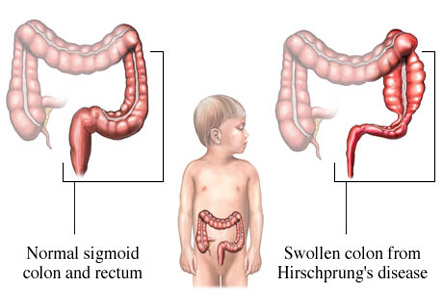Hirschsprung Disease
Introduction
Hirschsprung’s disease occurs when some of the nerve cells which are normally present in the intestine do not form properly while a baby is developing in the womb.
For digestion of food, muscles move food forward through the intestines in a movement called as peristalsis. When we eat, nerve cells that are present in the wall of the intestines receive signals from the brain for contraction of the intestinal muscles to move food forward.
In children with Hirschsprung’s disease, a lack of nerve cells in part of the intestine interrupts the signal from the brain and prevents peristalsis in that segment of the intestine. As a result, stool cannot move forward normally and the intestine can become partially or completely obstructed. It begins to expand to a larger than normal size.
The severity of the symptoms depends on how much of the intestine has normal nerve cells present. In seventy percent of babies with Hirschsprung’s disease, there are missing nerve cells in only the last one to two feet of the large intestine.
Iranian specialists have made remarkable achievements in infants' surgeries and Iran is among few countries that have gained access to the latest surgical technologies

Cause of Hirschsprung’s disease:
The nerve cells of the digestive tract develop between the 5th and the 12th weeks of pregnancy in the fetus. The nerve cell formation begins from the mouth and finish in the anus. For unknown reasons, the nerve cells do not grow past a certain point in the intestine in fetuses with Hirschsprung’s disease.
The exact cause of this problem is not yet known.
The severity of the symptoms depends on how much of the intestine has normal nerve cells present.
Hirschsprung’s disease occurs in 1 out of every 5,000 live births. It occurs five times more frequently in males than in females. Children with Down syndrome have a higher risk of developing Hirschsprung’s disease.
If a family has one child with Hirschsprung’s disease, there is a 3 to 12 percent chance that another baby will also have the disease. Also, there is an increased chance that a couple will have a child with Hirschsprung’s disease if one of the parents has the disease.
Problems due to Hirschsprung’s disease:
The digested food and stool cannot move forward through the portion of the digestive tract which lacks the nerve cells. The intestine becomes blocked with stool, and the baby becomes constipated or unable to have normal bowel movements.
The obstruction (blockage) causes pressure on the inside of the intestinal wall, causing part of the intestinal wall to thin out. Eventually, a bacterial infection can develop in the digestive tract, causing serious problems.
Symptoms of Hirschsprung’s disease:
Most of the children with Hirschsprung’s disease show symptoms in the first 6 weeks of life. Children with affection of only a short segment of intestine may not show symptoms for several months or years. The following are the most common symptoms of Hirschsprung’s disease:
• Lack of bowel movement in the first 48 hours of life
• Gradual bloating of the abdomen
• Vomiting
• Fever
Children who do not have early symptoms may also present with the following:
• Constipation that becomes progressively worse
• Loss of appetite
• Delayed growth
• Watery stools
Diagnosis:
A physician examines the child and obtains complete medical history. Other tests may be done to evaluate whether the child has Hirschsprung’s disease. These tests may include:
1. Abdominal x-ray –this may show a lack of stool in the large intestine or near the anus and dilated segments of the large and small intestine.
2. Barium enema –this procedure is performed to examine the large intestine for abnormalities. A fluid called barium is given into the rectum as an enema. The barium helps in visualization of strictures, obstructions, and dilated intestine above the obstruction on abdominal X-ray.
3. Anorectalmanometry – This test measures nerve reflexes which are missing in Hirschsprung’s disease.
4. Biopsy of the rectum or large intestine – a sample of the cells in the rectum or large intestine is looked for nerve cells under a microscope.
Treatment for Hirschsprung’s disease:
The treatment for Hirschsprung’s disease is determined by the following:
• The extent of the problem
• The child’s age, overall health
• Medical history
• The opinion of the child’s physician
An operation is usually necessary to deal with intestinal obstruction caused by Hirschsprung’s disease. The surgeon removes the portion of the rectum and intestine which lacks normal nerve cells. A colostomy is performed so that stool can leave the body. In colostomy, the upper end of the intestine is brought through an opening in the abdomen called as a stoma. Stool will pass through the opening and then into a collection bag. The colostomy may be temporary or permanent, depending on the amount of intestine that is needed to be removed. After a healing period, many children can have the intestine surgically reconnected above to the anal opening and have the colostomy closed.